(Strand)om Stories: Wolverine: Prehistory Review
This volume provides the best look at Logan's pre-X-Men years, offering fun, if not occasionally inconsistent, glimpses into the mutant's many adventures
—by Nathan on September 16, 2023—
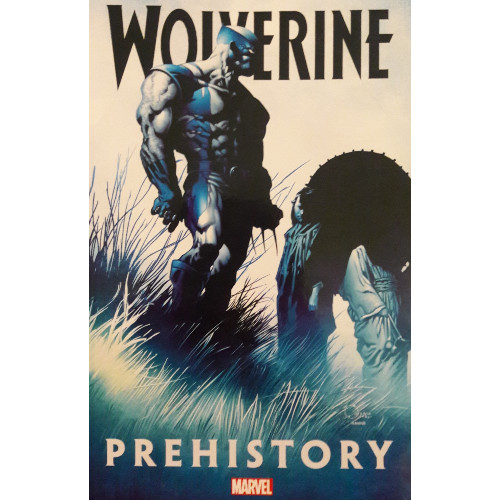
I don’t know who at Marvel first decided, "Y’know what we should do? Establish that James Howlett, the enigmatic Logan, the wandering Wolverine, has been around for nearly two hundred years. That sounds like a great idea." Cause it certainly does. Suddenly, a character who’s generally been a ridiculously popular X-Men has so much additional history to potentially uncover. You’ve got this guy who, now, could have fought in two World Wars, Korea, Vietnam, Afghanistan…someone who saw the world and technology and politics develop around him. A guy who witnessed the change in attitudes towards mutants and saw the rise of the X-Men years before he joined the team.
Logan, from his inception, was a blank slate, a white piece of paper you could start adding color to. Pieces were gradually uncovered–his claws protruded from his arms rather than from the gloves he wore, and he was actually born with bone claws which were then later coated in adamantium (along with the rest of his skeleton) by the Weapon X program. I suppose all of this adds to the character’s appeal: just who is this guy and what was he doing before Charles Xavier invited him to join his second band of X-Men?
Wolverine: Prehistory seeks to shine a light into those shadowed corners. The volume is a collection of various limited series and one-shots published throughout the last three decades about our favorite Canadian killer. It’s not a series, more of an anthology…and, if anything else, more of an unintentional anthology. We’ll see what happens when folks cherry pick "Wolverine in the past" stories and slap them together chronologically with not much tethering between them other than the passing of years.
Wolverine: Prehistory
Writers: Tim Truman, Mark Millar, Rick Spears, Howard Mackie, Mark Jason, Neal Adams, Christos Gage, Larry Hama, Joe Casey, David Lapham, Vince Hernandez, Jeff Parker, and Karl Bollers
Pencilers: Todd Foxx, Kaare Andrews, Timothy Green II, John Paul Leon, Tomm Coker, Neal Adams, Cary Nord, Stephen Platt, Johnny Timmons, Luke Ross, Benton Jew, and Stephen Segovia
Inkers: Gary Kwapisz, Kaare Andrews, Timothy Green, Shawn Martinbrough, Keith Aiken, Andrew Currie, Neal Adams, Scott Hanna, Walden Wong, Johnny Timmons, Luke Ross, Benton Jew, Octavio Cariello, Stephen Segovia, Batt, Larry Stucker, Bob Wiacek, Mark Pennington, Johnny Greene, Scott Koblish, and Rodney Ramos
Colorists: Tom Smith, Jose Villarrubia, Veronica Gandini, Gregory Wright, Christie Scheele, Matthew Wilson, Joe Rosas, Kevin Somers, Malibu’s Hues & Colorgraphics with Guru-eFX, Elizabeth Dismang Breitweister, and Rain Beredo
Letterers: Michael Hiesler, Tom Orzechowski, Virtual Calligraphy’s Randy Gentile and Clayton Cowles, Richard Starking, Comicraft Inc.’s Emerson Miranda, Oscar Gongora, and Troy Peteri, and Artmonkeys Studios & Blambot’s Nate Piekos
Issues Collected: Marvel Comics Presents #93-98, Wolverine: The Amazing Immortal Man and Other Tales, Wolverine #32, Wolverine #1000, Logan: Path of the Warlord, Wolverine: Agent of Atlas #1-3, Logan: Shadow Society, The First X-Men #1-5, Wolverine: Hunger, Wolverine #-1, Before the Fantastic Four: Ben Grimm & Logan #1-3, Wolverine/Cable: Guts and Glory
Volume Publication Date: February 2017
Issue Publication Dates: January 1992-March 1992, Feburary 1996, Feburary 1997, July 1997, October 1999, July 2000-September 2000, November 2005, July 2008, December 2008-January 2009, April 2009, April 2011, October 2012-March 2013
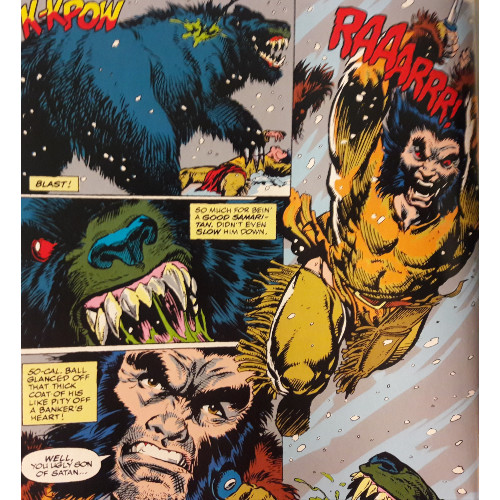
This volume, it should be noted, is not exhaustive in collecting "pre-X-Men Wolverine" stories. Both Paul Jenkins’ Origins and Barry Windsor-Smith’s Weapon X, to name a few, are not included. But as mentioned above, you get the gist of this collection fairly quickly: we are exploring, in in-universe chronological order, the history of Wolverine before he joined the X-Men. It doesn’t matter if a story published in 2012 chronologically takes place before a tale published in 1999; it’s gonna get slotted where it belongs, based on the Marvel Universe timeline. For the sake of this blog, however, I’ve listed the issue publication dates in real world chronology. I figured jumping back and forth would be confusing in trying to align each date with their specific series or issue. You’re welcome if you wish to be.
In theory–and, admittedly, largely in execution–the concept behind this collection is solid and entertaining. If you’re going to read about Wolverine’s history, which has been altered and tacked on to during the last several decades, you’d probably do best reading it in this format. You move through the decades with Wolverine, following a time-based thread woven throughout the whole volume even if the narrative connections between issues are lacking. And I cannot say I’m disappointed by the lack of interwoven story arcs, characters, etc., because I never expected a narrative throughline. A few of the stories are intentionally connected (such as Wolverine #-1 and Before the Fantastic Four), but I knew going into the volume this would largely be a hodge-podge. That was part of my interest, I’ll admit, the appeal of seeing how these seemingly random one-shots and series worked together when they were never intended to in the beginning.
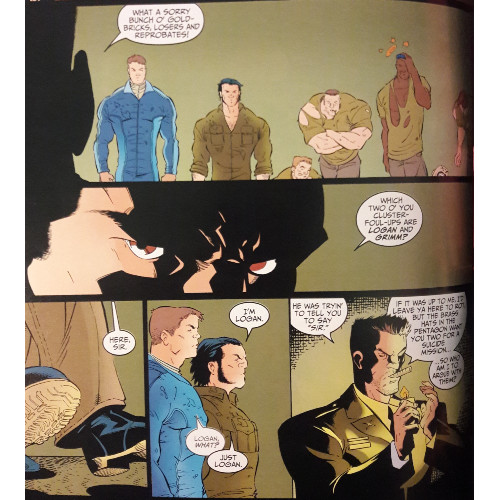
Several of the collected stories are easy to place chronologically. Stories about Wolverine screwing with a Nazi commander in a concentration camp (also collected in Wolverine: Enemy of the State) or infiltrating a Nazi cult dedicated to creating werewolves are solidly set in World War II; tales where Wolverine teams with the Agents of Atlas or gets involved in other Cold War-era shenanigans usually make reference to their relative time period, marking themselves as coming after World War II but making no mention yet of the X-Men. A brief tale focusing on the immediate aftermath of Logan’s escape from the Weapon X facility is cleverly placed at the end of The First X-Men series, which finishes with Logan approached by operatives of the program. Overall, the volume is easy to follow, allowing the reader to "connect the dots." It’s an imaginative exercise where none existed previously.
Sometimes, story placement feels a tad odd. The first story, told in the Marvel Comics Presents issues, dances between a wandering Logan and a dream/flashback (it’s never fully explained which) where he teams up with some Native Americans to battle a demon. The time period for the "wandering Logan" sequences is never specified, though it seems relatively modern, meaning this story seems to have been placed first in the volume because of the flashback/dream sequence. But no dates are given, meaning we’re kinda left to imagine when this takes place.
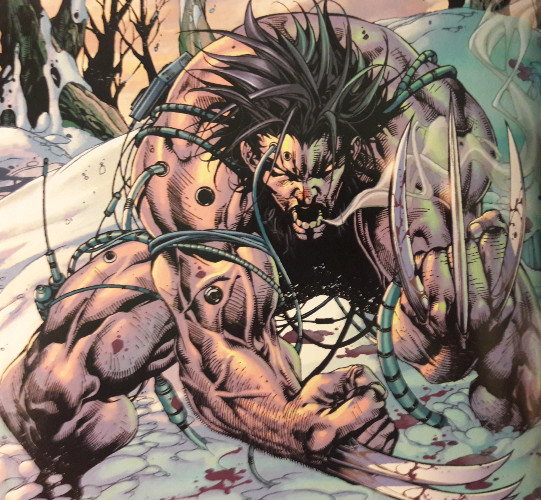
Though no central story exists, the volume’s format allows for other kinds of development, namely, a sense of progression for Wolverine as history itself shifts. The Logan who teams with Native American tribsemen seems somewhat aimless, wandering the U.S./Canadian border without much of a purpose. Skip to the Second World War, and we suddenly get a Logan who’s a hero before he ever donned a suit and mask, fighting werewolves out of a courageous sense of fortitude and self-sacrifice (or maybe he just really hates Nazis). The deeper we move into the Cold War, the closer we reach the original Marvel era of comics. I was pleasantly surprised at how these stories hinted at or casually referenced mutants…this underlying secret slowly becoming more prominent in society.
It’s a fun progression to watch develop. You go from stories in a society which knows nothing of mutants, with people viewing Logan as this incredible fighter, soldier, and secret agent without knowing what he really is (and, presumably, without him knowing either), to tales in a world slowly waking up to the idea that the strange and fantastic is happening all around them. Wolverine: Shadow Society hints at this burgeoning change in the status quo, with the First X-Men series pulling that conflict to the fore. The volume suddenly shifts in tone. No longer is Logan the isolated warrior, fighting battles no other man can. Now, he’s at the forefront of a genetic shift, the birth of the Marvel Universe as we know it today, far before anyone would have imagined him being when he joined Charles Xavier’s new team in Giant-Size X-Men #1, or even when he debuted in Incredible Hulk #181. Heck, by calling their series "First X-Men," Christos Gage and Neal Adams engagingly introduce a group of mutants before Xavier’s team, putting Logan front-and-center in an emerging world Xavier only was beginning to explore.
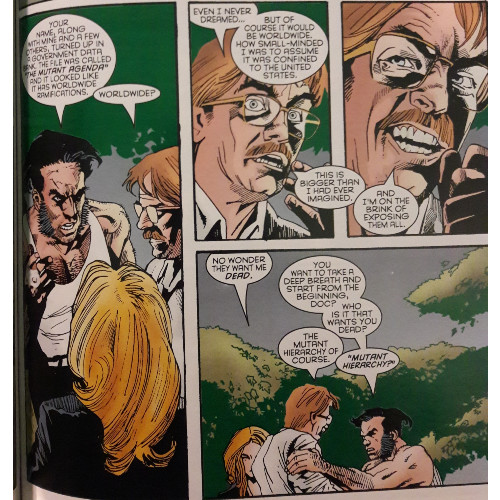
So, collectively, the volume works well enough. But what about the individual stories contained therein? Most of them have to be read individually (again, because no larger narrative exists), and most of them stand on their own fairly well. Most of the stories are one-shots, told quickly and then moving on. Millar and Andrews’ Wolverine #32 is a haunting depiction of a nearly wordless Wolverine, while the Amazing Immortal Man one-shot presents a decently human view of the character. Over the years, Wolverine becomes a circus act, a warrior, a soldier, a mercenary, a prisoner, a lab rat, a superhero, a government operative…he wears so many masks, heightening his appeal. This is a man who has done so much over the years, and I’m grateful we get even a tiny peek into his expansive history.
Small problems exist here and there, primarily in little continuity errors. Shadow Society, published in February 1997, heavily focuses on the partnership between Carol Danvers and Logan. Wolverine #-1, published in July 1997, has Nick Fury reintroduce himself to Logan (correctly noting they knew each other during World War II) and then introduces Carol, also present. Logan claims to not know Fury, which is understandable–the Weapon X experiments have wiped his memory. But while Logan would not remember either Fury or Carol, why Fury doesn’t try to remind Logan of Carol, just himself, is a head-scratcher.
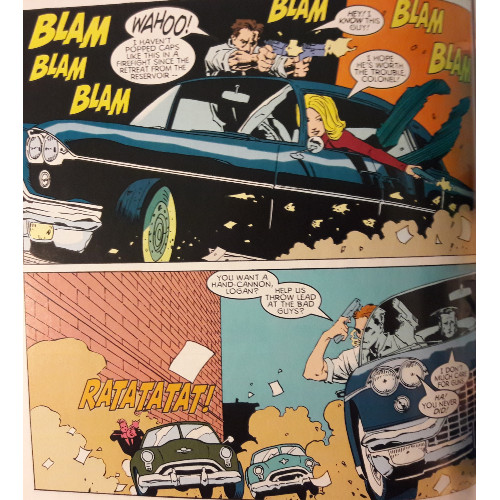
A tiny blip also happens in Wolverine #1000, where Logan confronts a tank head-on in two different stories. In the first, Logan fully withstands a blast from the tank point-blank; in the second, Logan is similarly bombarded, noting he’s "[ne]ver been shot by a tank before." The first tale sees Logan launch from the smoke, killing the tank operatives; the second sees him "spend a full day healing in a blast crater." Two different creative teams worked on each story, yes, but it seems a strange detail to present differently…maybe the first blast missed him? Unlikely. And before anyone brings up the chronology (maybe the second story takes place before the first?), each story is clearly dated–the first in 1944, the second in 1945. A minor editorial error which I have harped on for too long already, but one which stood out.
Given minor inconsistencies, it’s amazing that most of this volume is solid, and even some potential continuity rifts can be sewn shut with a little imagination. Three different stories feature Wolverine's arch-nemesis Sabretooth–Shadow Society, The First X-Men, and Wolverine #-1. Presented as enemies in Shadow Society (Sabretooth indicates they "have got a major score to settle"), the two are allied temporarily in The First X-Men, before being back at other’s throats in the #-1 issue. The First X-Men ends with their partnership dissolving, and Logan correctly cannot remember Sabretooth in the #-1 issue, with the Weapon X experiments occurring between each tale. I am, perhaps, slightly confused that the two jump from enemies in Shadow Society to allies (and even friends) in The First X-Men–if they’ve got so much bloody history, as Sabretooth implies, what caused them to momentarily patch up the dam? That’s where imagination enters the scene. I suppose you can concoct a narrative where they made up their pasts and joined forces for a greater cause under the burgeoning banner of assisting mutantkind.
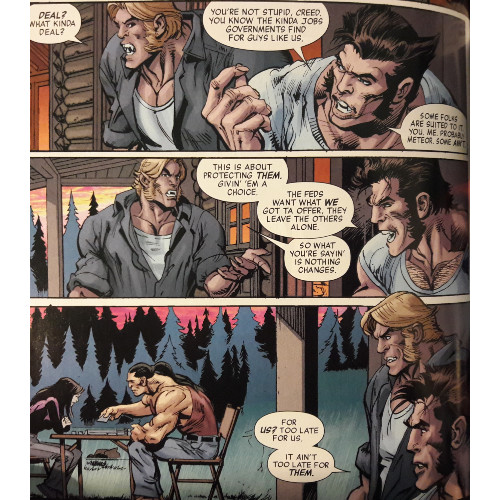
Strewn throughout the entire volume are references and Easter eggs Wolverine, X-Men, and even Marvel fans in general will appreciate. These are, mostly, utilized very well. A problem I generally associate with stories told in the past, yet published after stories told in the present, is the retroactive insertion of references to the present. Writers try to introduce clever foreshadowing, which usually just feels lazy. A little bit of that exists here: both the Marvel Comics Presents issues and the Wolverine/Cable one-shot offer explanations for Logan’s "Wolverine" name–Marvel Comics Presents informs us the Native American tribe Logan aids gives him the moniker, while the Wolverine/Cable issue indicates "Wolverine" is a codename offered by Department H. Again, could we just imagine that, throughout the years, multiple people believed that, given Logan’s brutish attitude and claws, he was most like a wolverine? Sure, but it seems a teensy bit far-fetched.
Better inserted are Easter eggs which do not carry this foreshadowing quality, woven in for fun. Logan wears an outfit in Marvel Comics Presents similar to his classic blue-and-yellow uniform; he encounters Nick Fury during World War II in Wolverine #1000; Shadow Society sees Wolverine infiltrate the Hellfire Club, which Claremont had introduced during his "Dark Phoenix Saga," and even features a brief appearance by a young Warren Worthington III, the future Angel (it should also be noted that, during his infiltration, Logan mentions he’ll use the sewers next time, a "foreshadowing" nod to "Dark Phoenix" I actually appreciated); in searching for possible mutants, Logan’s "first" X-Men encounter a bearded vagrant with incredible strength, who is never named but is absolutely an amnesic Prince Namor; Cable, in the "present," encounters and is hilariously defeated by the Vulture, on his first crime spree before he fights Spider-Man; and in his team-up with pilot Ben Grimm, Logan hears plenty of the future Thing’s famous catchphrase: "It’s clobberin’ time!" These are, as I said, simply fun details, engaging ways to weave in larger pieces of Marvel lore without feeling overwrought or needlessly retroactive.

If you’re looking for a volume which tells an intentionally-chronological account of Logan’s passage through the centuries, woven together by a deeper plot, this is not the collection for you. I’m not even sure Marvel has ever dedicated a limited series or a longer-running plot specifically following Logan from his formative years through the present. But if you don’t mind one-or-two historical inconsistencies and want to read the best approximation of Logan’s winding walk through the world, this is a fairly beefy, decently well-rounded volume to pick up. It’s not exhaustive, as I said earlier, but it contains enough variety and engaging references to entertain a litany of fans as Logan goes from wandering warrior to mutant activist, becoming embroiled in an ever-shifting world even before he shakes Professor Charles Xavier’s hand.